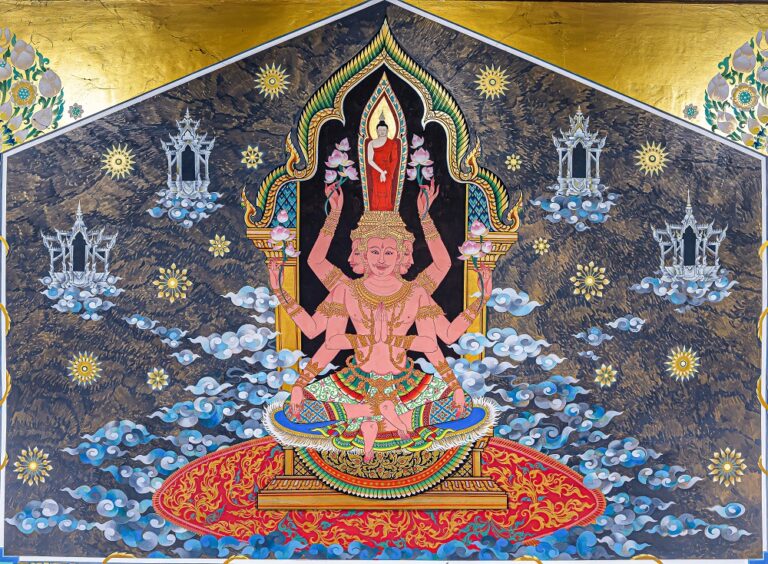
CONQUEST OVER BAKA BRAHMA
In this mural we see Baka Brahma and the many faces of the evil Mara acting through him, with the Buddha demonstrating his higher consciousness by hiding where Baka cannot see him.
Baka believed that he had attained the highest world as a Brahma. He also believed that his world was permanent and would never decay.
The Buddha told Baka about anitya, or “impermanence,” but Baka’s attendant said that Baka was the creator, and that those who praised Baka would be rewarded, and those who did not would be punished.
The Buddha realised that the evil Mara was speaking through the attendant. Mara wanted to keep Baka under his influence by allowing him to maintain his deluded ideas. Most importantly, Mara wanted to prevent the Buddha from sharing his knowledge with the world. Mara always speaks through someone else and never directly shows his face.
The Buddha told Mara that he was free from his grasp. Then, Baka tried to logically trap the Buddha in his realm, which he thought was universal. Baka said that if the Buddha depended upon anything within Baka’s realm, then the Buddha would be within that realm, and Baka could act upon him as he saw fit.
The Buddha responded that Baka could do this, but there were many realms of which Baka had no idea. Baka’s realm was neither highest nor universal. The Buddha’s knowledge therefore placed him outside of Baka’s realm.
The Buddha also told Baka’s about his past lives, showing Baka that he had greater insight into his history than Baka himself. Baka had previously been an ascetic who saved many people, so he was reborn as a deva. But over the course of many lives, he had gradually sunk back down to the level of an ordinary Brahma.
Furthermore, the Buddha asserted that there is consciousness outside of the six senses. This is an important teaching of the Dhamma, but even it was not enough to convince Baka.
Baka and his followers were convinced only when the Buddha displayed his superior powers by performing a supernatural miracle that was beyond their understanding. The Buddha hid from Baka and his followers, so they could hear him but not see him. The demonstration was so powerful that Baka and his followers were immediately convinced of the Buddha’s superiority.
This mural is one of several that shows how the Buddha taught by example, not merely by ideas. The evidence of his power in the physical world was often what won over his followers, even if it was his teachings that had lasting influence. His miracles were performed not merely for shock value, but to subdue his followers’ pride, thereby opening them to the practice, or “stream-entry.”